You can get a pretty great Android phone for $400 these days. Even the Nexus 6 with its huge AMOD display full metal body, is reasonably priced ($499 on Amazon). So if a phone is going to carry a big premium price like the Galaxy S7 or G5, it needs to offer a little extra innovation.
The HTC 10 is a refreshing step forward for HTC. It’s elegant reserved, focusing on the four main areas that make a phone great: design, performance, camera, audio. But while I appreciate the restraint HTC has shown in not throwing tons of questionable features at us, it doesn’t take that extra step to offer any real innovation. There’s nothing wrong with that—some might even prefer it—but when there are so many good sub-$500 phones on the market, it’s hard to justify the HTC 10’s $699 price.
Fixing last year’s design flaws
HTC could be credited with starting the trend toward solid metal unibody phone designs, but the look feel of the original HTC One hasn’t evolved fast enough. The HTC 10 obviously carries forth its “One M” flagship series lineage, but updated it in all the right ways. The trademark metal body smooth curved back are still there, the headphone jack is still in the middle of the top edge. But most of the annoyances from the One M8 M9 are gone.
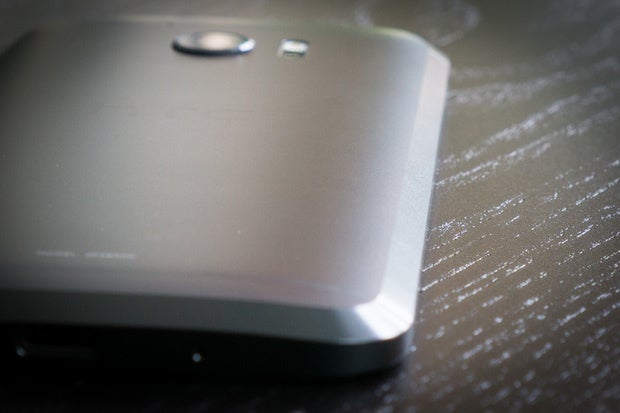

Get a load of that huge beveled edge.
A wide 45-degree beveled edge makes the phone easy to hold comfortable to grip. ge-to-edge glass on the front gives the HTC 10 a sleek modern look, while gracefully getting rid of the big metal “forehead chin” on the front of past HTC One phones. The big black bar with the HTC logo is no longer found beneath the display. The power volume buttons on the right edge are easy to find with your thumb. And, yes, the camera module protrudes from the back, but only just slightly.
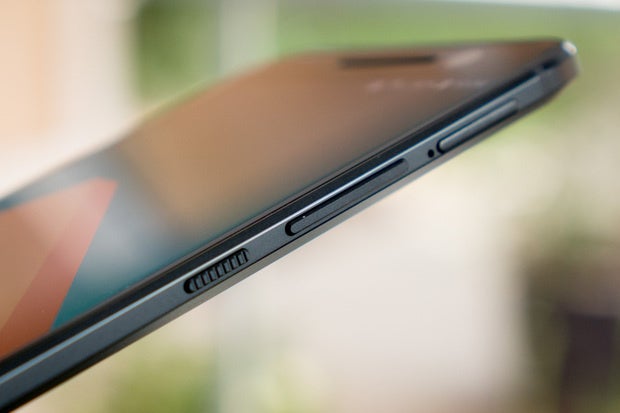

The power volume buttons are clicky, well-placed, easy to distinguish with your thumb.
The combination home button fingerprint sensor (it’s lightning-fast accurate) is flanked by capacitive Back Recents buttons. So even though HTC bumped up the screen size to 5.2 inches, the phone is just barely larger than the One M9.
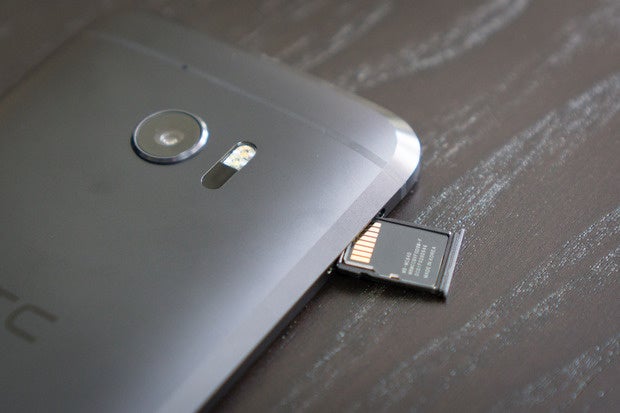

MicroSD cards are definitely a thing this year.
The result is a rigid, durable-feeling, understated design that looks every bit like a premium phone for 2016— every bit like an HTC.
The performance you expect
If you’re shipping a high-end phone in 2016, it’s got to have a Snapdragon 820, or at least something that performs like it. The HTC 10 has the chip you expect, as well as 4GB of RAM, 32GB of storage, a microSD expansion slot.
In terms of performance, it blows the doors off the One M9, but that phone had problems with thermal management. More importantly, it’s right in line with other Snapdragon 820-powered phones you’d buy this spring. The benchmark results are so close that the differences are immaterial. In practice, the phone flies: Every interaction is fast, scrolling is smooth, apps launch quickly, there are no unwelcome stutters or hiccups.
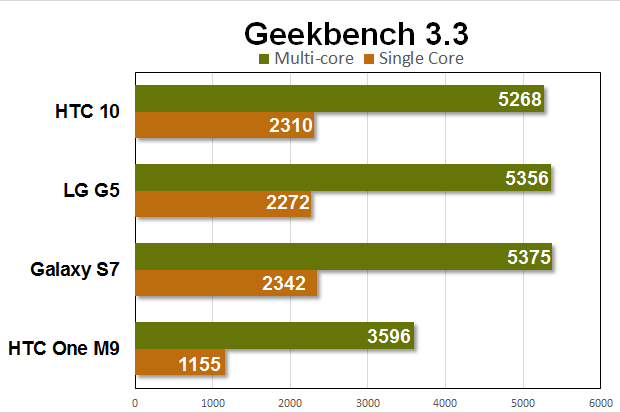

rformance is on par with other Snapdragon 820 powered phones. ich is to say, very fast.
Battery life is very good thanks to a fairly efficient processor a 3,000mAh battery. In our battery benchmarks, it was on par with the G5 a little behind the Galaxy S7, whose efficient AMOD display sips a bit less power when calibrated to the 200 cd/m² brightness at which we test. During everyday use, the HTC 10 seemed quite similar to those two other phones, easily taking me through a full day of mixed use with about four hours of screen-on time (with auto-brightness enabled).
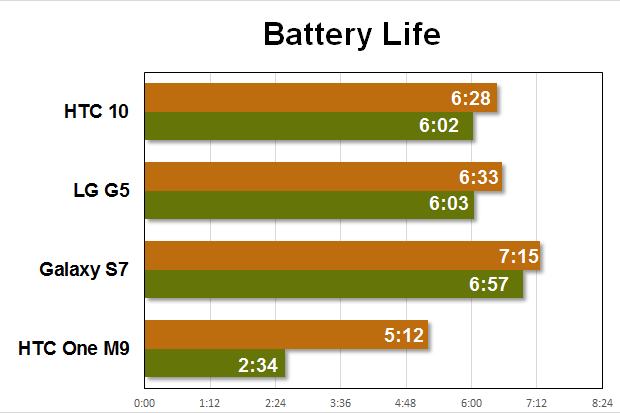

Battery life is good, will take all but the most deming users through a full day on a single charge.
Charging up is lightning fast. The HTC 10 has got a B-C port, but doesn’t use regular B-C charging rates. That is, when attached to a power source like the Nexus 5X or 6chargers, it charges at normal speed, not rapidly. The phone instead incorporates Qualcomm’s Quick Charge 3.0 technology, includes such a charger in the box. I went from 0 to 50% charged in just half an hour, with a full 100% charge taking roughly 1.5 hours.
Now this is a great camera
I’m not ready to proclaim the HTC 10 as the best camera of any Android phone. Not quite. but it is certainly among the best. The rear camera features a 12-megapixel sensor with 1.55 micron pixels (probably the same Sony IMX377 found in the Nexus 6, with a super wide f/1.8 lens, laser autofocus, optical image stabilization (OIS), two-tone D flash. It takes 4K video 120fps slo-mo video (sadly, there’s no 240fps slo-mo mode). The results are fantastic.
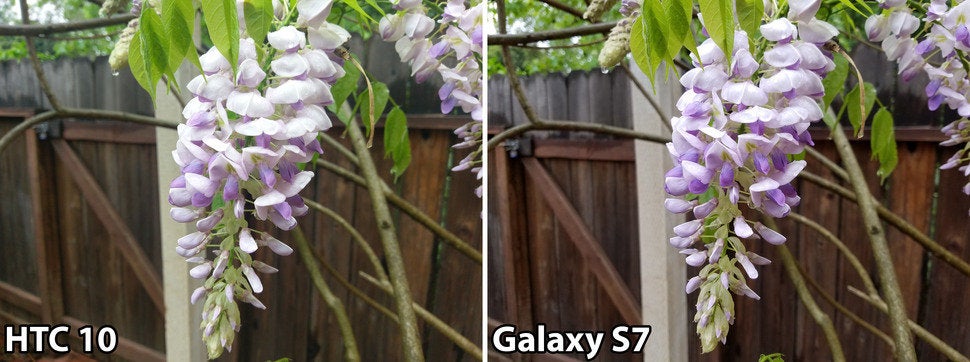

The Galaxy S7’s colors are a little more saturated, but the HTC 10’s are a bit more true-to-life. Both deliver great depth of field.
w-light performance might be even better than what you’ll find from the Galaxy S7. In many situations, you’d be hard-pressed to definitively say which phone took the better photo: the HTC 10 or Galaxy S7. In better light, the two are surprisingly comparable. But HTC’s camera seems to hle challenging lighting situations a bit better. It appears that the depth of field is a teeny bit shallower on the HTC 10 (probably due to a slightly larger sensor size) the white balance is a touch warmer.
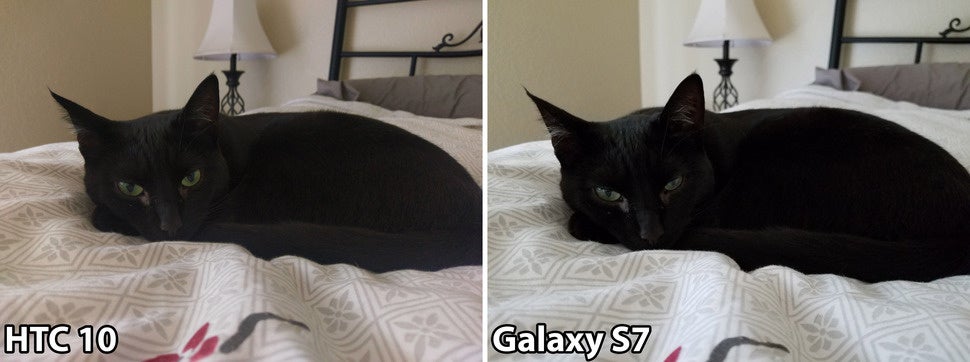

You try taking a picture of a black cat in poor indoor light. The HTC 10’s white balance is a touch warmer, the fur is better exposed.
en it comes to software, HTC’s camera app is eminently usable. It’s simple clear, with only a few common controls visible. The app launches fast, shutter lag is minimal, so you can go from pocket to photo fast enough not to miss a great moment. If you want more control, the o mode lets you adjust exposure, ISO, shutter speed (up to 2 seconds maximum), focus, white balance. You can save the photo in RAformat, too.


I know which phone I’d rather use to ruin my romantic dinner by taking pictures of my food.
The front camera is “only” 5 megapixels, but it also features a wide f/1.8 aperture, even OIS—a first on smartphones. The bottom line is that HTC nailed it with the camera on the 10. It takes fantastic photos videos simply, quickly, easily.
Bring out the Boom
Ever since the original HTC One gave us dramatically better audio quality under the BoomSound br, the company has packed its premium phones with impressive stereo speakers. The 10 is no exception, even if the configuration is a little weird. The speakers are asymmetrical: The bottom-firing speaker acts as a “woofer” focusing on the low end of the audio spectrum, while the speaker in the earpiece faces forward acts as a “tweeter,” reaching into the high frequencies. Each speaker is amplified separately.
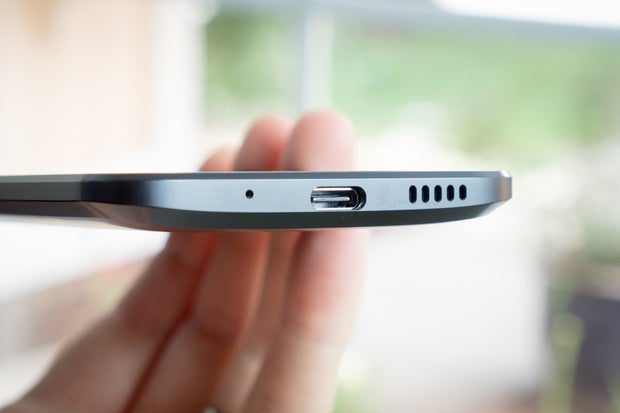

Having one down-firing speaker one front-firing speaker is a little weird.
Add in a little Dolby audio enhancement, you get a really good-sounding phone. Of course, a little smartphone is never going to pump out sound equivalent to even a small Bluetooth speaker, but as phones go, the audio is impressive.
ug in headphones you can step through an audio profiling setup process that essentially works like an equalizer, adjusting the sound output to match the frequency response of your headphones ( hearing).


The audio profiling feature can make a big difference if you have crummy headphones.
But it’s not all about speakers headphones. The HTC 10 has a full 24-bit audio DS DAC, can even record 24-bit audio when filming video. If you have a really, really good pair of headphones, the right audio files, you can enjoy high resolution audio. ly, it’s probably far more important that a phone sounds great when you listen to Spotify or ra, fortunately, the HTC 10 does.
Sense 8: A very mild Android skin
HTC’s Sense interface was a godsend back in the days of KitKat. But stock Android started to gel in Android llipop (5.0), it’s even better in Marshmallow. Today, when manufacturers like or Samsung change up icons, quick settings, toggles, buttons, menus to their own design, they’re doing more harm than good.
Credit goes to HTC, then, for making Sense 8 stick close to ’s own Android vision. The quick settings shade, recent apps interface, notifications, volume sliders, most of the Settings menu look almost exactly like stock Android. HTC has made a few tweaks where necessary, you’ll notice differences here there (the app drawer isn’t like ’s, but it’s close enough in form function that you won’t care). Most annoying is HTC’s insistence on pushing Blinkfeed, which is still “just okay.” I’d rather have Now cards to the left of my home screen.
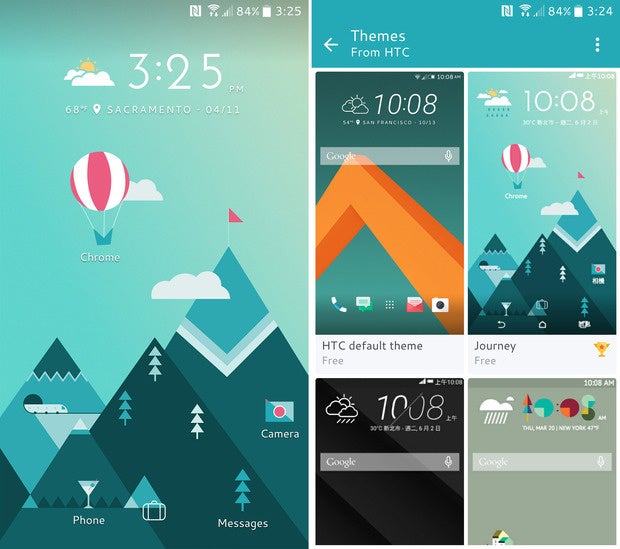

The new Freestyle layouts let you put app links anywhere, attached to stickers (left). The Themes store is full of creative stuff (right).
ich brings us to the topic of bloatware. HTC has cut way back on it, at least in the unlocked carrier-free version I reviewed. Some apps like Facebook, Instagram, Facebook Messenger are pre-installed cannot be removed, but the number of such bundled apps are few. Most ultra-premium phones have a lot more cruft.
HTC has even gotten rid of a number of its own apps. It doesn’t include it’s own browser; you just get Chrome. There’s no HTC fitness app, just Fit. Given HTC’s deal with UnderArmor, this is a delightful surprise. You won’t find office apps besides Docs, Sheets, Slides, Keep. HTC scrapped its own gallery app in favor of otos.
HTC hasn’t exorcised all its own software, however. The company still ships its own dialer, clock, weather app, SMS app. None of them are really better than ’s stuff, but they’re not worse, their design fits in well with Material Design stards. Nothing seems out of place.
Using the HTC 10 is a delight. If you’re used to stock Android, you’ll feel right at home. Most of the changes are sensible minimal. I wouldn’t want HTC to forsake useful gestures like double-tap to wake, for instance. Outside of wanting Now in place of Blinkfeed, I never felt the urge to switch to the launcher. I can’t say that about most other high-end Android phones.
The ability to extensively theme your phone is my favorite feature in the One M9, it’s back with the 10. In fact, it’s better than ever. You can install existing themes, new “Freestyle layouts” let you put apps anywhere instead of sticking to a 4×5 grid. You can also link “stickers” to apps to avoid using icons altogether. It’s the most polished theming experience to ship with any major Android phone, it’s a lot of fun.
A killer $500 phone that costs $700
HTC dropped the “One “M” from the HTC 10’s name. It’s a perfect analog to the company’s thinking about this phone. ere other manufacturers pile on features proprietary gimmicks, HTC cuts away unnecessary flotsam. ere competitors try to do everything all at once, HTC focuses on what’s most important: design, performance, imaging, audio. Other manufacturers duplicate services software, HTC got rid of many of its own proprietary apps.
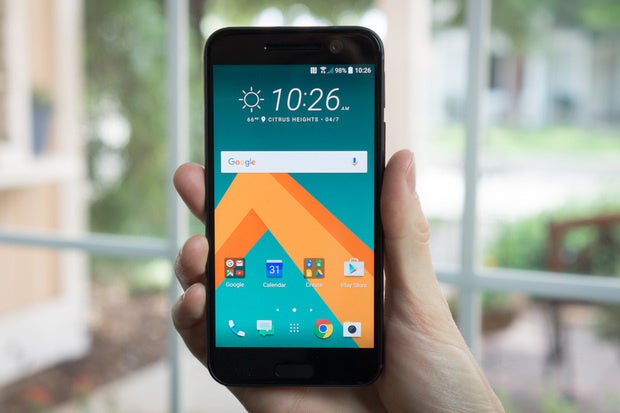

It’s hard to justify this phone’s $700 asking price. If it’s steeply discounted, snap it up.
It’s not as if this is a Nexus phone. But it’s about as close as you’re likely to see from a major top-tier Android manufacturer. ly, as much as I like stock Android, I’m thankful for HTC’s themes camera app.
Now, all that said, as much as I like the HTC 10’s “less is more” approach, I still feel like something’s missing. This isn’t a $500 phone; HTC has priced it at $699. For that kind of money, I expect a little more innovation. I expect waterproofing, or fast wireless charging, or an always-on display, or built-in Twitch game streaming, or side benefits like the Oculus/GearVR partnership for premium Samsung phones.
If this phone cost what a Nexus 6does, I would recommend it to everyone. I could then clearly say that this phone’s benefits offset the always-up-to-date Android software you get with the Nexus phone. But this phone doesn’t cost what the Nexus 6does. It costs a whopping $200 more. HTC’s got a killer $500 phone here, they’re shooting themselves in the foot by asking $700 for it.














